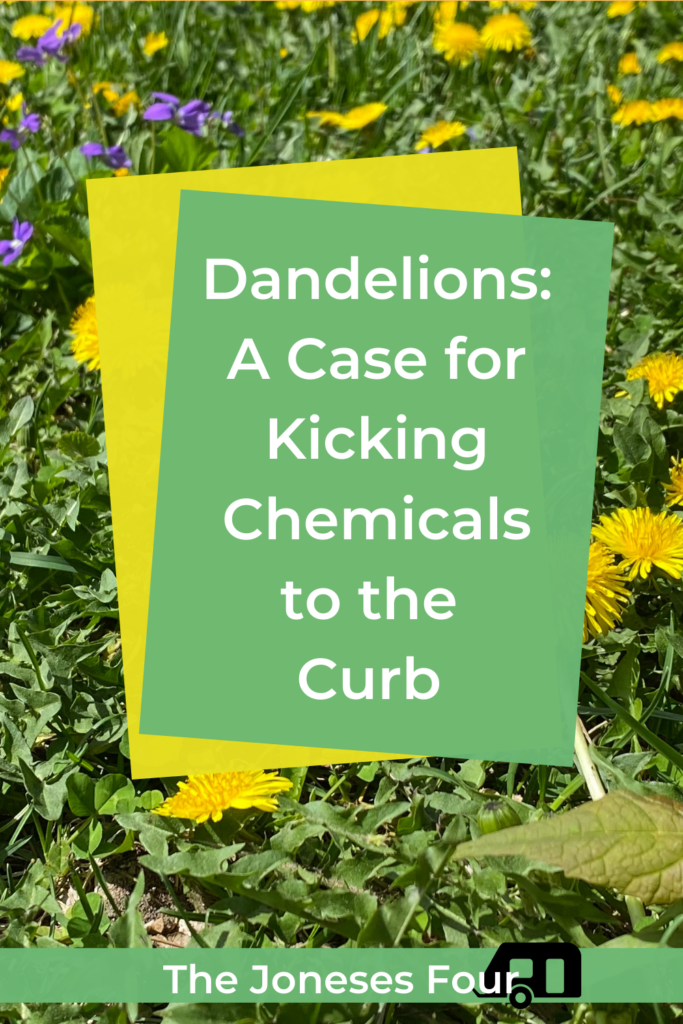Every spring, I see a lot of misinformation being spread about dandelions. Many American yards are in a war against them and their weapon of choice is a toxic, cancer-causing chemical. A chemical, might I add, that’s produced by a company with heavy political influence (cha-ching!) and a class action lawsuit filed against it (re: cancer). But that’s for another day.
Unfortunately, a lot of these (probably well-intentioned) people believe and spread misinformation about dandelions in support of the spray. Much of this information is inaccurate and its spread is as toxic as the chemicals on their yard.
So in an effort to stop the spread of misinformation and to help support my fellow bee lovers, I wrote the following post. To make sure that I also wasn’t spreading any misinformation, before posting it, I reached out to the DNR’s invasive species contact for western Wisconsin to verify its accuracy. (The last thing we want to do is spread more misinformation!) This person also works as a beekeeping instructor. She happily signed off on its content.

This post contains affiliate links.
Are Dandelions good for bees?
Dandelions — a weed to some, a happy flower to others — serve as an important first food for bees and other pollinators. Dandelions are not an ideal food for bees, BUT they are available before most other flowers, which makes them a significant source of food.
Are Dandelions invasive?
Dandelions are naturalized. They are not native to our area, however, they also don’t choke out other species, hence they are not considered invasive. Our ecology has adapted to their presence. (Please also note that the highly sought after green grass yard is also not native. It also requires a lot of water to maintain.)
Value Beyond Pollinators
Dandelions have a significant value beyond bees and other pollinators. They’re not just naturalized ecologically; think of the role they’ve played in our lives.
Dandelions are a childhood staple
Our kids frequently have yellow-painted noses and make wishes on those little tufts of fluff. There’s also their contribution as an early science lesson when kids pull apart the stems and watch them curl in a glass of water (hydrophobic exterior/hydrolific interior).
Dandelions are 100% edible: People have been using their components in salads, wine, muffins, tinctures, salves, and more for a very long time.
The only safe way to get rid of dandelions
If you want to get rid of dandelions, the safest way to do so is to dig them out by hand. If your neighbors have them in their yard and you don’t like them, ask them if you can dig them out for them. Some people will say no because they think they’re cute and/or they want to keep them for the bees; some people don’t think trying to eradicate them is worth their time or they simply don’t have the time; some people don’t care either way.
The big picture
I know I’m not going to be able convince some of you that (non-native) turf grass isn’t the most aesthetically pleasing way to maintain your yard, but please understand, that some of us want safe yards for our children and pets, a place for wildlife to safely call home, and the water that flows from our yard into our streets, lakes, rivers and eventually into the water table to be as free of pollutants as possible. If you enjoy using your local waterways for recreation, please know that maintaining chemical-free yard is one of the best ways to keep your lakes from turning green.
As a family, we think dandelions are adorable and our yard is full of them. The majority of my neighbors’ yards are (voluntarily — even enthusiastically) filled with them, as well, and we’re grateful for that.
Final notes on dandelions
The point is that dandelions not only serve an important role for bees, but that they also cause no harm; methods for trying to get rid of them, however, can have devastating short and long-term effects for people and the planet. Please reflect on the facts before treating your yard with chemicals because of a benign yellow flower.
Summary
- Dandelions are not classified as invasive. They’re considered a naturalized, non-native plant.
- While dandelions are not native, neither is turf grass. If you’d like a yard full of native plants, see this post for some planting ideas.
- Chemicals are not a solution. They have devastating effects well beyond your yard and the season. (Related: If you’re not happy about the green lakes in your area, stop fertilizing.)
- Dandelions have benefits that impact more than just your yard and the bees: think childhood memories, kitchen applications, and homeopathic remedies.
I hope you found the contents in this post valuable. If you’re a yard sprayer, I hope you’ll pause before your next application, and if you’re a dandelion enthusiast, I hope you’ll share your favorite thing about or use for them in the comment section below.
Have a dandy day. 😉
— Melissa, The Joneses Four





